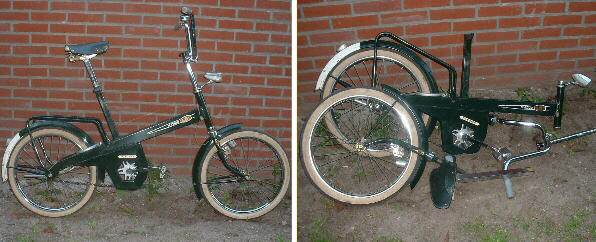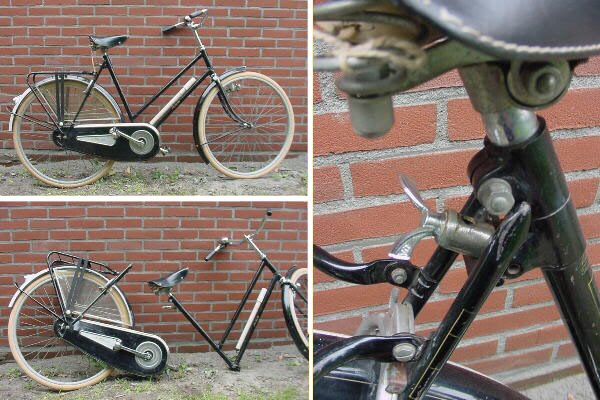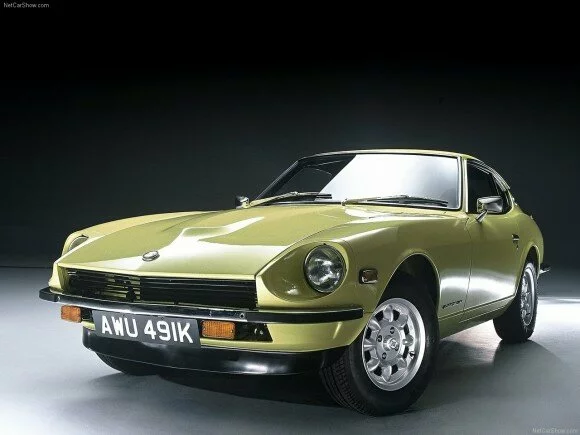 Manufacturer : Honda
Manufacturer : Honda
 Productions : 1981
Productions : 1981
 Engine : Twin cylinder Air-cooled Four-stroke, Single Over Head Cam Parallel twin.
Engine : Twin cylinder Air-cooled Four-stroke, Single Over Head Cam Parallel twin.
 Transmission : -
Transmission : -
Honda introduced several 200 cm³ bikes with similar engines but different body variations in the 1980s. The model introduced in South Africa and Pakistan was known as the CD 200 “Road Master”. It was a detuned version of the Honda CD185 twin. The CD 200 sold more for its looks then performance as its square speedometer, huge front and rear mudguards, twin chrome exhausts, neatly tucked in choke behind handle bars and a chrome plated fuel tank with the Honda logo contributed to an interesting styling.
The bike was a cheap commuter vehicle with a claimed 100 miles (160 km) per gallon and a smooth ride. Too slow for a 200 cm³ bike, its top speed was only 70 mph (112 km/h) as the engine was detuned to keep maintenance cost to a minimum. This bike targeted users who wanted a comfortable cheap transport suitable for long routes with low maintenance. Use of simple drum breaks in rear and front and a single carburetor were other measures used to keep the maintenance low. The bike accelerated hard up to 65 mph (105 km/h); after that it was a flat ride. The engine had to be revved very hard to create any kind of excitement as the bike was too heavy (140 kg) for an engine that produced a modest 16 bhp.
This model suffered from various manufacturing faults like a noisy cam chain and an unreliable electrical starter (later models were upgraded with 12 volts CDI system in the UK.). In the UK the CD200 was affected by legislation restricting learner riders to bikes limited to 125 cm³ and 12bhp. Honda introduced a 125 cm³ Benly after the CD200 was withdrawn.The CD 200 Road Master was sold in South Africa until late 2004 and was used mainly as a courier/delivery bike.It retained the 6 volt electrics and points ignition.
January 24, 2011 – 3:16 pm
April 15, 2011 – 11:43 pm
1966 Honda RC166 250 Specification :
 Manufacturer : Honda
Manufacturer : Honda
 Productions : 1966
Productions : 1966
 Engine : 250 cc
Engine : 250 cc
However technically interesting and highly developed the Honda RC116 and RC149 may be, the most appealing, the most glamorous racing bike ever built is no doubt the 1966 Honda RC166 six. Although the Italians are known for their creations, Carcano’s masterpiece, the Moto Guzzi V8 500 cc, was a lumpish, ungainly hunk of a motorcycle when compared to the sleek, beautiful lines of the Honda. It’s the comparison between a dray horse and a thoroughbred. In addition to its specifications and beauty came the incomparable, ear-splitting howl of its six megaphones and its invincibility in the hands of Mike Hailwood, which made it a legend in its time.
Although outwardly very like the RC165, internally the engine has been changed and now has a bore and stroke of 41 x 31 mm. See second image at left. Carburetors have cylindrical slides, although sometimes flat slides are used. Power output is 60 bhp at 18,000 rpm. Like the RC149, the bike has oil coolers in the right and left hand side of the fairing. Also new are the brakes, which have now radial cooling fins instead of circumferential ones. Dry weight of the seven speed bike is 112 kg.
 Manufacturer : Honda
Manufacturer : Honda
 Productions : 1978-1979
Productions : 1978-1979
 Engine : 1751 cc SOHC CVCC I4
Engine : 1751 cc SOHC CVCC I4
 Transmission : 5-speed manual transmission, and 68 hp with a 2-speed automatic
Transmission : 5-speed manual transmission, and 68 hp with a 2-speed automatic
 Source : netcarshow.com
Source : netcarshow.com
The Honda Prelude was a front wheel drive I4-engined coupe that was manufactured by Honda between 1978 and 2001. It spanned five generations of cars but was discontinued upon the release of the fourth-generation Honda Integra in Japan in late 2001, due to its decreasing sales and popularity.
The Prelude’s perennial competitor has been the Toyota Celica, another I4-powered coupe introduced several years prior to the Prelude. Throughout the 1980s, it was challenged by the Nissan Silvia, Isuzu Impulse, Mitsubishi FTO, Mitsubishi Cordia (later the Eclipse), and the Mazda MX-6.
March 13, 2011 – 10:44 am
January 23, 2011 – 10:39 am

|
| Fongers M2000 1968 |
Specification:
Manufacturer : Fongers
Production : 1968
Type : Folding Bike
Source : oudefiets.nl
August 21, 2010 – 11:14 pm

|
| Fongers M66 1966 |
Specification:
Manufacturer : Fongers
Production : 1966
Type : Folding Bike
Source : oudefiets.nl
January 22, 2011 – 10:41 pm

|
| Batavus Portable 1965 |
Specification:
Manufacturer : Batavus
Production : 1965
Type : Folding Bike
Source : oudefiets.nl
April 25, 2011 – 12:10 pm
Fiat Tempra 1990-1998 Specification and Picture :
 Manufacturer : Fiat
Manufacturer : Fiat
 Productions : 1990-1998
Productions : 1990-1998
 Engine : 1.4 L I4, 1.6 L I4, 1.8 L I4, 1.9 L diesel I4, 1.9 L turbodiesel I4, 2.0 L I4, 2.0 L I4 DOHC Turbo
Engine : 1.4 L I4, 1.6 L I4, 1.8 L I4, 1.9 L diesel I4, 1.9 L turbodiesel I4, 2.0 L I4, 2.0 L I4 DOHC Turbo
 Transmission : 5-speed manual, 4-speed automatic, CVT.
Transmission : 5-speed manual, 4-speed automatic, CVT.
The Tempra’s engine range was similar to that of the Tipo. Initially 1.4 and 1.6-litre models had carburettor engines. Both of these models were discontinued in 1992 due to the new European emission standards and thus all models from 1992 on had catalytic converters and electronic injection. Transmission was a standard 5 speed manual, but for the first time a mid size sedan was offered as with a continuously variable transmission which was previously available on Fiat Uno, Panda, Ritmo and Tipo. 2.0-litre-models were also available with an optional 4-speed automatic transmission.
During its 6 year production run, few changes were made apart from a minor facelift in 1993 resulting in a new front grille and other minor styling changes.
Chassis and main parts (most notably, the doors) were shared with the Fiat Tipo. Other vehicles, derived from the same project were Lancia Dedra (Tempra’s most similar cousin, sharing all mechanical components), Lancia Delta second generation, Alfa Romeo 155, Alfa 145 and Alfa 146.

 Manufacturer : Nissan
Manufacturer : Nissan
 Productions : 1970
Productions : 1970
 Engine : 2.0 litre straight-6
Engine : 2.0 litre straight-6
 Transmission : 5-speed manual transmission
Transmission : 5-speed manual transmission
 Source : netcarshow.com
Source : netcarshow.com
The Nissan S30 (sold in Japan as the Nissan Fairlady Z and in other markets as the Datsun 240Z and later as the 260Z and 280Z) was the first generation of Z sporty 2 seater and 2+2 coupes produced by Nissan Motors, Ltd. of Japan from 1969 to 1978. It was designed by a team led by Mr. Yoshihiko Matsuo, the head of Nissan’s Sports Car Styling Studio. HLS30 was the designation of the left-hand drive model and HS30 for the right-hand drive model.
The Fairlady Z was introduced in late 1969 as a 1970 model, with the L20A 2.0 litre straight-6 SOHC engine, rear wheel drive, and a stylish coupe body. The engine, based on the Datsun 510′s 4-cylinder, produced 150 hp (112 kW) and came with a 5-speed manual transmission (240Z models received the L24 2.4 litre engine and a 4-speed manual). A less common 3-speed automatic transmission was optional from 1971 on, and had a “Nissan Full Automatic” badge. A 4-wheel independent suspension consisted of MacPherson struts in front (borrowed from the Datsun Laurel C30) and Chapman struts in back. Front disc brakes and rear drums were standard.
![]() Manufacturer : Honda
Manufacturer : Honda![]() Productions : 1981
Productions : 1981![]() Engine : Twin cylinder Air-cooled Four-stroke, Single Over Head Cam Parallel twin.
Engine : Twin cylinder Air-cooled Four-stroke, Single Over Head Cam Parallel twin.![]() Transmission : -
Transmission : -














